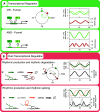Circadian mRNA expression: insights from modeling and transcriptomics
- PMID: 26496725
- PMCID: PMC11108398
- DOI: 10.1007/s00018-015-2072-2
Circadian mRNA expression: insights from modeling and transcriptomics
Abstract
Circadian clocks synchronize organisms to the 24 h rhythms of the environment. These clocks persist under constant conditions, have their origin at the cellular level, and produce an output of rhythmic mRNA expression affecting thousands of transcripts in many mammalian cell types. Here, we review the charting of circadian output rhythms in mRNA expression, focusing on mammals. We emphasize the challenges in statistics, interpretation, and quantitative descriptions that such investigations have faced and continue to face, and outline remaining outstanding questions.
Keywords: Biostatistics; Circadian; Post-transcriptional regulation; Systems biology; mRNA expression.
Figures




Similar articles
-
RNA-based regulation in the plant circadian clock.Trends Plant Sci. 2011 Oct;16(10):517-23. doi: 10.1016/j.tplants.2011.06.002. Epub 2011 Jul 23. Trends Plant Sci. 2011. PMID: 21782493 Review.
-
Critical role of deadenylation in regulating poly(A) rhythms and circadian gene expression.PLoS Comput Biol. 2020 Apr 27;16(4):e1007842. doi: 10.1371/journal.pcbi.1007842. eCollection 2020 Apr. PLoS Comput Biol. 2020. PMID: 32339166 Free PMC article.
-
Circadian genomics reveal a role for post-transcriptional regulation in mammals.Biochemistry. 2015 Jan 20;54(2):124-33. doi: 10.1021/bi500707c. Epub 2014 Dec 30. Biochemistry. 2015. PMID: 25303020 Free PMC article. Review.
-
Spotlight on post-transcriptional control in the circadian system.Cell Mol Life Sci. 2011 Jan;68(1):71-83. doi: 10.1007/s00018-010-0513-5. Epub 2010 Aug 30. Cell Mol Life Sci. 2011. PMID: 20803230 Free PMC article. Review.
-
Translating around the clock: Multi-level regulation of post-transcriptional processes by the circadian clock.Cell Signal. 2021 Apr;80:109904. doi: 10.1016/j.cellsig.2020.109904. Epub 2020 Dec 25. Cell Signal. 2021. PMID: 33370580 Free PMC article. Review.
Cited by
-
A conditional Smg6 mutant mouse model reveals circadian clock regulation through the nonsense-mediated mRNA decay pathway.Sci Adv. 2023 Jan 13;9(2):eade2828. doi: 10.1126/sciadv.ade2828. Epub 2023 Jan 13. Sci Adv. 2023. PMID: 36638184 Free PMC article.
-
Principles for circadian orchestration of metabolic pathways.Proc Natl Acad Sci U S A. 2017 Feb 14;114(7):1572-1577. doi: 10.1073/pnas.1613103114. Epub 2017 Feb 3. Proc Natl Acad Sci U S A. 2017. PMID: 28159888 Free PMC article.
-
The Making and Breaking of RNAs: Dynamics of Rhythmic RNA Expression in Mammals.J Biol Rhythms. 2020 Dec;35(6):519-529. doi: 10.1177/0748730420957498. Epub 2020 Sep 23. J Biol Rhythms. 2020. PMID: 32965157 Free PMC article. Review.
-
Circadian rhythms in septic shock patients.Ann Intensive Care. 2021 Apr 26;11(1):64. doi: 10.1186/s13613-021-00833-5. Ann Intensive Care. 2021. PMID: 33900485 Free PMC article.
-
First-passage time statistics of stochastic transcription process for time-dependent reaction rates.Eur Phys J E Soft Matter. 2019 Feb 25;42(2):24. doi: 10.1140/epje/i2019-11788-8. Eur Phys J E Soft Matter. 2019. PMID: 30793216
References
-
- Eskin A. Identification and physiology of circadian pacemakers. Introduction. Fed Proc. 1979;38:2570–2572. - PubMed
-
- Pittendrigh CS (1965) Biological clocks, the functions, ancient and modern, of biological oscillations. In: Sci. Sixties Proc. 1965 Cloudcroft Symp. Air Force Office of Scientific Research, Arlington, VA., pp 96–111
-
- Hamner KC, Finn JC, Sirohi GS, Hoshizaki T, Carpenter BH. The biological clock at the south pole. Nature. 1962;195:476–480. doi: 10.1038/195476a0. - DOI
Publication types
MeSH terms
Substances
LinkOut - more resources
Full Text Sources

